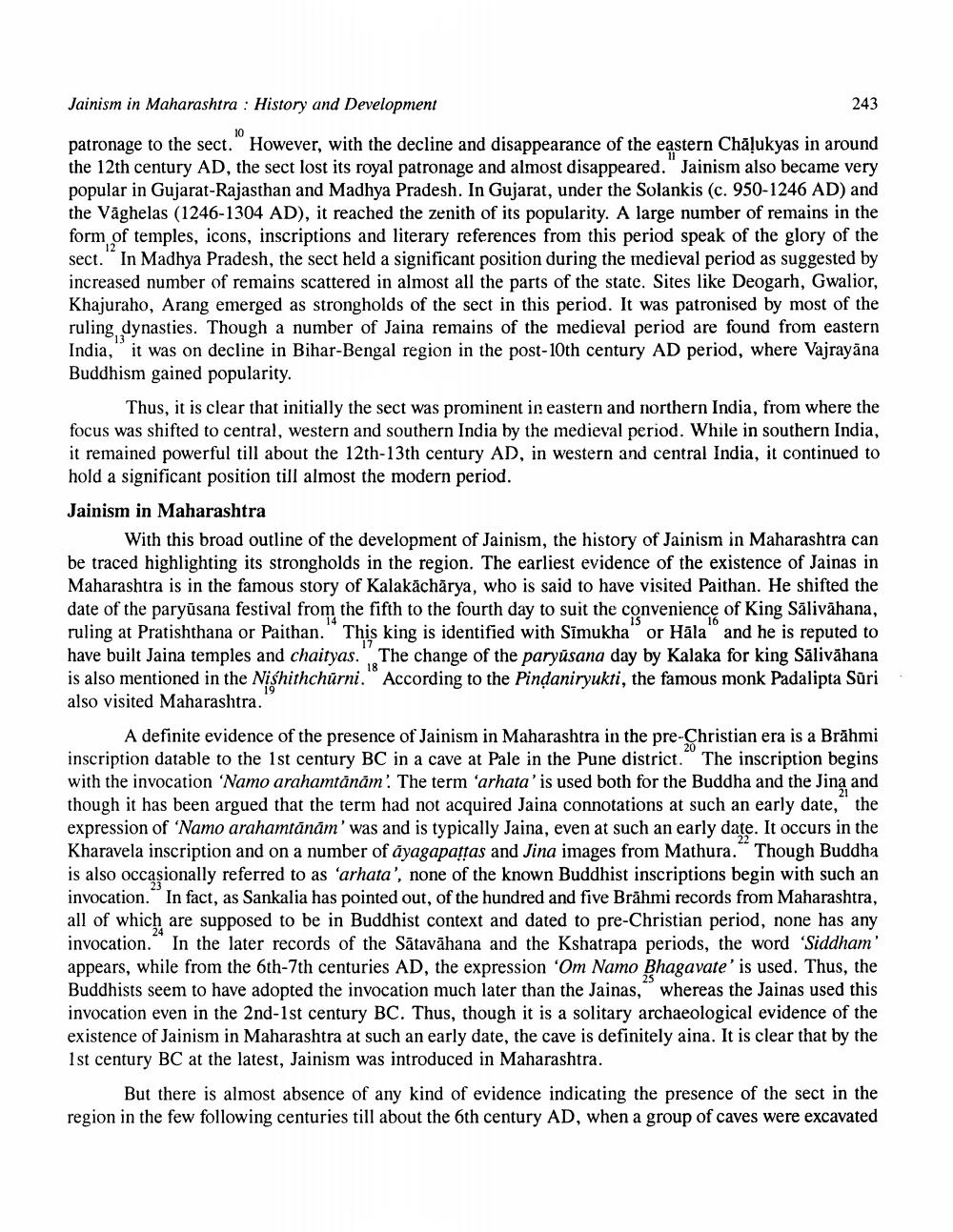________________
Jainism in Maharashtra : History and Development
243 patronage to the sect. However, with the decline and disappearance of the eastern Chāļukyas in around the 12th century AD, the sect lost its royal patronage and almost disappeared." Jainism also became very popular in Gujarat-Rajasthan and Madhya Pradesh. In Gujarat, under the Solankis (c. 950-1246 AD) and the Vāghelas (1246-1304 AD), it reached the zenith of its popularity. A large number of remains in the form of temples, icons, inscriptions and literary references from this period speak of the glory of the sect. In Madhya Pradesh, the sect held a significant position during the medieval period as suggested by increased number of remains scattered in almost all the parts of the state. Sites like Deogarh, Gwalior, Khajuraho, Arang emerged as strongholds of the sect in this period. It was patronised by most of the ruling dynasties. Though a number of Jaina remains of the medieval period are found from eastern India, it was on decline in Bihar-Bengal region in the post-10th century AD period, where Vajrayāna Buddhism gained popularity.
Thus, it is clear that initially the sect was prominent in eastern and northern India, from where the focus was shifted to central, western and southern India by the medieval period. While in southern India, it remained powerful till about the 12th-13th century AD, in western and central India, it continued to hold a significant position till almost the modern period. Jainism in Maharashtra
With this broad outline of the development of Jainism, the history of Jainism in Maharashtra can be traced highlighting its strongholds in the region. The earliest evidence of the existence of Jainas in Maharashtra is in the famous story of Kalakāchārya, who is said to have visited Paithan. He shifted the date of the paryūsana festival from the fifth to the fourth day to suit the convenience of King Sālivāhana, ruling at Pratishthana or Paithan. This king is identified with Sīmukha or Hāla and he is reputed to have built Jaina temples and chaityas. The change of the paryūsana day by Kalaka for king Sālivāhana is also mentioned in the Nishithchūrni. According to the Pindaniryukti, the famous monk Padalipta Sūri also visited Maharashtra.
A definite evidence of the presence of Jainism in Maharashtra in the pre-Christian era is a Brāhmi inscription datable to the 1st century BC in a cave at Pale in the Pune district. The inscription begins with the invocation 'Namo arahamtānām! The term 'arhata' is used both for the Buddha and the Jina and though it has been argued that the term had not acquired Jaina connotations at such an early date, the expression of 'Namo arahamtānam' was and is typically Jaina, even at such an early date. It occurs in the Kharavela inscription and on a number of ayagapattas and Jina images from Mathura. Though Buddha is also occasionally referred to as 'arhata', none of the known Buddhist inscriptions begin with such an invocation. In fact, as Sankalia has pointed out, of the hundred and five Brāhmi records from Maharashtra, all of which are supposed to be in Buddhist context and dated to pre-Christian period, none has any invocation. In the later records of the Sātavāhana and the Kshatrapa periods, the word 'Siddham' appears, while from the 6th-7th centuries AD, the expression 'Om Namo Bhagavate' is used. Thus, the Buddhists seem to have adopted the invocation much later than the Jainas," whereas the Jainas used this invocation even in the 2nd-1st century BC. Thus, though it is a solitary archaeological evidence of the existence of Jainism in Maharashtra at such an early date, the cave is definitely aina. It is clear that by the 1st century BC at the latest, Jainism was introduced in Maharashtra.
But there is almost absence of any kind of evidence indicating the presence of the sect in the region in the few following centuries till about the 6th century AD, when a group of caves were excavated




